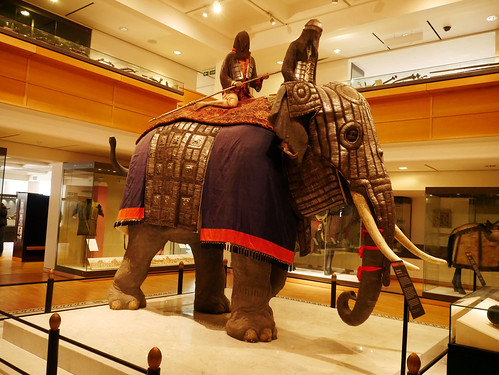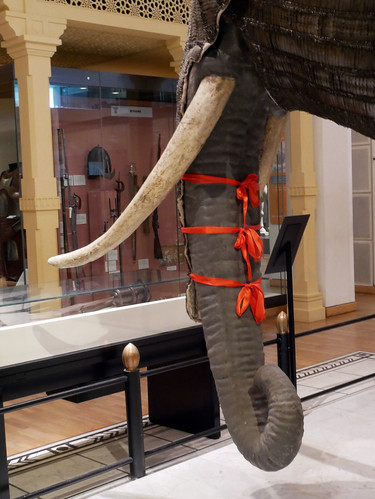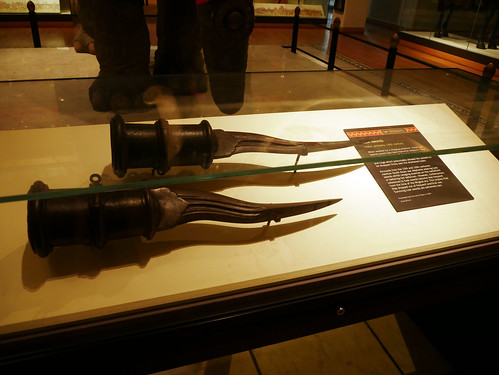Elephants played a role in warfare from the first millennium BC until the 19th century. They were used mainly in India and Southeast Asia but also occasionally in western Asia, north Africa, Spain and Italy.
During battles trained war elephants were able to trample men and horses or pick them up and throw them. They also performed an important function as intimidating vantage platforms from which rulers and high-ranking officials could direct their forces.
Elephants were prominent targets on the battlefield and their protections was important. From at least the 11th century AD until well into the Mughal period, sources from across the Indian subcontinent describe or illustrate war elephants equipped with different types of bargustavan-i-pil (elephant armour).
The reputation of war elephants was so fearsome that their true military value is difficult to assess. *
This example of elephant armour (bargustavan-i-pil) is from India and probably dated late 16th – 17th century.
This is the only known surviving example of a near-complete mail and plate elephant armour in any public collection in the world. It was probably made in an Indian arsenal in the late 16th or 17th century, but it is difficult to be certain exactly where or for whom.
The mail and plate structure for body armour was used mostly in northern and central India during this time, and is often associated more with the equipment of Muslim states. Yet this armour is decorated with peacocks, lotus blooms and fish, perhaps suggesting it was produced in an area which retained elements of Hindu culture.
The armour would originally have been formed of eight panels, three at either side of the body and one each for the head and the throat. Two of the main sections from the right side of the elephant are missing. *
The armour also has a pair of tusk swords that attached to the sawn-off tusks of the elephant.
When wielded by a charging elephant, these tusk swords would have been fearsome weapons. They are extremely robust with massive reinforced points and rings which presumably allowed the sockets to be strapped firmly over the shortened tusks.
Accounts from the 15th and 16th centuries mention South Asian war elephants wearing tusk swords whilst ravaging enemies on the battlefield or battering fort defences. However, contemporary references to tusk swords become less frequent from the time of the Mughal era. This implies that they dropped out of frequent practical use. Surviving tusk swords are extremely rare.*
*from information boards next to the exhibit













The elephant armour was both functional and beautiful. It must have been well made since this set survived hundreds of years.
The armour is a work of art and as you say beautiful. I am amazing that this armour is so intact, apart from the missing pieces.
This is highly interesting and just amazing that they at least have this armour to have on display. This must be very difficult for elephants to fight, for in my mind they are very friendly and they “never” forget. But once “very angry” they are highly dangerous, how do you train them to kill the “bad ones”….
Those tusk swords….. you have to have respect for them.
Beautiful exhibition.
I think by training it means being handled by the rider to behave in certain ways in certain circumstances. In the way other animals are trained.
But as you say if they got out of control they would be highly dangerous. And in a battle situation?
A very interesting post – the armour is just superb. A lovely set of photos.
This is the ‘one’ exhibit in the museum that I just had to see I found it fascinating. The eastern displays around it were also extremely interesting.
I found it fascinating. The eastern displays around it were also extremely interesting.
Are mighty elephants afraid of tiny mice?
I don’t know, do you?
I don’t even want to imagine what such a war would look like, Cherry. It makes me sick to my stomach. (sigh) God have mercy on us all.
I think it was graphically described in ‘Lord of the Rings’.
Not only did humans suffer in war but so too did many animals.
War is a great destroyer of life both directly and indirectly.
a pity that these gentle giants were conditioned into being war machines, CP. but a thoroughly engaging post and it was mostly new to me.
It was new to me too and like you I found it fascinating.
It seems that man has a compulsion for war, these days it is with man made technology rather than animals. But animals still suffer as a consequence of war.
what a magnificent of the war elephant Cherie…
i got into your site with the URL that you sent me by email….peter:)
what an interesting presentation of the War Elephant Cherie…
the link that you sent me into by email works and i bookmarked the page…
hopefully it will allow me to get back into your site in the future….peter:)